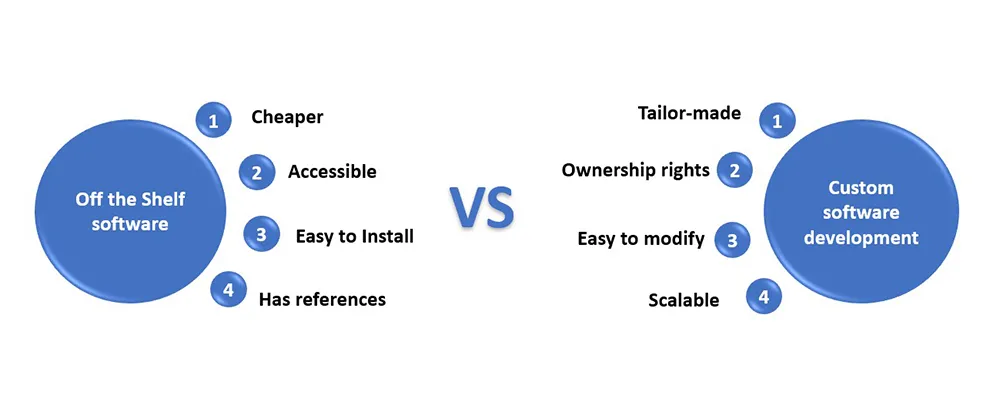Custom vs Off-the-Shelf Software: The 2025 Business Guide
In today’s rapidly changing digital landscape, selecting the appropriate software for your company may make or break your operations. With so many tools accessible, it is vital to grasp the distinction between custom software and off-the-shelf software, and which method best corresponds with your 2025 business objectives.
What is Off-the-Shelf Software?
Off-the-shelf software, alternatively referred to as Commercial Off-The-Shelf (COTS), is pre-developed and available for immediate use by a general audience. Some examples include Microsoft Office, Salesforce, Shopify, and QuickBooks. These programs are made to tackle generic business requirements and include vendor support, periodic updates, and common features.
Advantages:
Disadvantages:
1. Rapid deployment (days to weeks).
2. Reduced initial expense.
3. Vendor support and regular updates.
1. Restricted customization.
2. Can necessitate changing your business processes to the software.
3. Can involve repeated subscription fees.
What is Custom Software?
Custom software, which is also known as bespoke software, is designed from scratch to address the specific needs of an individual organization. Whether it is automating workflow, compliance-driven processes, or niche integrations, customized solutions are made for your business.
Advantages:
Disadvantages:
1. Completely adjustable to your requirements.
2. Smooth incorporation with current tools.
3. Adaptable for sustained expansion.
4. Distinct competitive edge.
1. Higher upfront cost.
2. The timeline of development is longer.
3. Dedicated support is required.
Difference between Custom Software and Off-the-Shelf Software
Custom Software:
Off-the-Shelf:
1. Low upfront, ongoing fees.
2. Quick deployment (days-weeks).
3. Limited customization.
4. Requires updates.
5. Minimal competitive edge
1. High upfront, long-term ROI.
2. Slow deployment (months-years).
3. Full flexibility.
4. Built to grow with you
5. High competitive edge
The AI Impact in 2025
AI-based coding tools such as Bolt, Replit, and Cursor are revolutionizing the software industry. Businesses can now develop internal tools within weeks rather than months, saving costs substantially.
- Netlify substituted costly SaaS products with AI-created applications.
- Small and medium-sized businesses are saving money by creating rather than subscribing.
AI is shifting the scale towards custom software, making it feasible even for small organizations.
Cost Analysis in 2025
Off-the-Shelf Software: Subscription pricing appears cheap, but per-user charges increase when your team grows. For instance, 20 employees on a $20/month tool for $4,800 per year.
Off-the-Shelf Software: Subscription pricing appears cheap, but per-user charges increase when your team grows. For instance, 20 employees on a $20/month tool for $4,800 per year.
Companies should compute Total Cost of Ownership (TCO), not initial cost.
How to Choose the Best Software Solution For Your Business
It’s important to consider the following factors while making a choice between custom software and off-the-shelf software:
- Define Your Needs: Off-the-shelf is fine. One-of-a-kind processes? Custom is the way.
- Check Resources: Do you possess developers or AI tools access?
- Compare Costs: Include subscription (COTS) versus long-term ROI (custom).
- Think Speed: Do you need it quickly? Off-the-shelf is your choice.
- Think Strategic: Desire a competitive advantage? Custom is your champion.
Future Outlook: 2025 and Beyond
- Hybrid Strategy: Most companies will combine both; beginning with off-the-shelf and transitioning gradually towards custom as they grow.
- AI-Driven Customization: Software will enable organizations to “personalize” off-the-shelf software without complete custom constructions.
- Security Imperatives: With the increase in cyber-attacks, custom solutions will become critical for organizations that require control over data.
Conclusion
We can say that if your business needs quick, affordable, and standard solution then you should go for the Off-the-shelf software. On the other hand, custom software is best for businesses that are seeking scalability, flexibility, and competitive advantage. In 2025, AI coding tools make custom development faster and cheaper, changing the way businesses approach software decisions.
Frequently Asked Questions (FAQs)
Custom software is developed especially for a firm’s requirements, whereas off-the-shelf software is packaged and ready for mass consumption. Custom provides flexibility and expandability, whereas off-the-shelf provides quickness and cost-effectiveness.
Not always. Custom software is ideal for companies with distinctive procedures and long-term plans for development. Off-the-shelf is ideal for companies that require quick, cost-effective, and routine solutions.
Custom solutions entail customized development, design, and integration, which demand more resources and time initially. But they tend to offer more ROI in the long term than subscription-based off-the-shelf tools.
AI-powered coding tools such as Bolt, Replit, and Cursor have brought down the cost and time to create custom software. This revolution makes custom development available for small and medium businesses rather than just large corporations.
Yes. With AI-powered development, small businesses can now create lightweight, bespoke internal tools for a fraction of the cost of traditional development. Already, numerous SMEs are cutting costs by building rather than subscribing.
